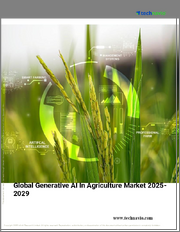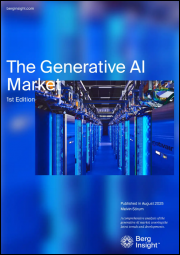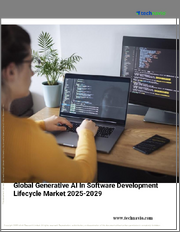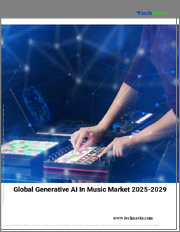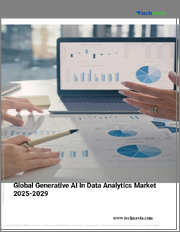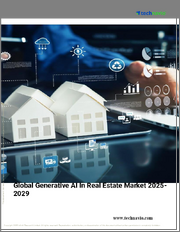
|
시장보고서
상품코드
1500695
세계의 생성형 AI 시장 : 세계 규모, 점유율, 동향 분석, 기회, 예측 보고서(2019-2030년)Generative AI Market - Global Size, Share, Trend Analysis, Opportunity and Forecast Report, 2019-2030, Segmented By Offering; By Modality; By Application; By End Use; By Region |
||||||
세계 생성형 AI 시장 규모가 복합 연간 성장률(CAGR) 26.12%로 5.7배로 확대 2030년까지는 983억 달러를 돌파할 것으로 예측됩니다.
세계 생성형 AI 시장은 컨텐츠 작성 수요 증가, 자동화의 진전, 신흥 및 혁신적인 AI 용도의 채용 확대에 의해 활황을 보이고 있습니다.
주요 전략 컨설팅 및 시장 조사 회사인 BlueWeave Consulting은 최근 설문 조사에서 2023년 세계 제너럴 AI 시장 규모를 173억 7,000만 달러로 추정했습니다. 2024년부터 2030년까지의 예측기간에서 BlueWeave는 세계 생성형 AI 시장 규모가 복합 연간 성장률(CAGR) 26.12%로 확대되어 2030년까지는 983억 1,000만 달러에 달할 것으로 예측했습니다. 세계 AI 시장은 엔터테인먼트, 게임, 광고, 디자인 등 다양한 산업에서 AI가 생성하는 컨텐츠에 대한 수요가 높아지고 있는 것이 배경에 있습니다. 이 시장에서는 방대한 데이터 세트와 강력한 컴퓨팅 인프라를 활용한 딥러닝 알고리즘과 신경망의 진보에 힘쓰고, 생성형 AI 기술의 채용이 증가하고 있습니다. 일반 인공지능이 지속적으로 가치를 입증함에 따라 학습 목적으로 사용 가능한 디지털 데이터가 증가하고 있음을 활용하는 새로운 용도와 이용 사례가 나타날 것으로 예상됩니다. 특히 OpenAI의 BigGAN이나 DALL-E와 같은 모델은 고품질의 비주얼을 생성하는 생성 모델의 가능성을 예시하고 있으며, 엔터테인먼트, 디자인, 광고, 컨텐츠 제작 등 다양한 업계에서 널리 채택 있습니다.
기회 - 클라우드 컴퓨팅과의 통합
일반 AI와 클라우드 컴퓨팅의 통합은 기술의 큰 발전을 의미하며 향상된 기능과 혁신적인 솔루션을 제공합니다. 이 시너지 효과를 통해 클라우드 서비스는 데이터 분석부터 사용자 참여에 이르기까지 다양한 용도로 제너레이션 AI의 힘을 활용할 수 있습니다. Azure Synapse Analytics, Azure 디지털 트윈, Azure Logic Apps 등의 예는 작업 자동화, 데이터 처리 혁신, 사용자 경험 향상으로 인해 제너럴 AI가 클라우드 서비스를 풍부하게 만드는 방법을 보여줍니다. 잠재적인 이점에도 불구하고 데이터 프라이버시 및 윤리적 고려 사항과 같은 과제를 해결해야 합니다. 그럼에도 불구하고 이 통합은 클라우드 컴퓨팅에 혁명을 일으키고 동적이고 개인화된 효율적인 솔루션을 비즈니스에 제공할 것을 약속합니다. 발전 AI 기술이 계속 발전함에 따라 클라우드 컴퓨팅과의 통합은 기술과 비즈니스의 미래를 형성하는 데 매우 중요한 역할을 할 것입니다.
지정학적 긴장 증가가 세계 제너럴 AI 시장에 미치는 영향
지정학적 긴장은 세계 제너럴 AI 시장에 다면적인 영향을 미칠 수 있습니다. 무역분쟁, 제재, 지정학적 분쟁 등의 지정학적 리스크 증가는 국제협력을 혼란스럽게 하고, 데이터의 자유로운 흐름을 저해하며, 생성형 AI 기술의 개발과 채용을 방해합니다. 게다가 지정학적 불안정성은 규제 환경과 지적 재산권에 불확실성을 가져와 투자 결정과 시장 역학에 영향을 미칩니다. 지정학적 긴장이 높아짐에 따라 기업은 국경을 넘어서는 협력관계와 시장 접근으로 과제에 직면할 수 있어 세계 생성형 AI 시장의 성장 전망을 제한하고 이 중요한 분야의 혁신을 정체시킵니다. 가능성이 있습니다.
세계 생성형 AI 시장
부문별 정보
생성형 AI 시장 : 최종 용도별
생성형 AI 시장은 최종 용도별로 미디어 및 엔터테인먼트, IT 및 통신, 게임, 헬스케어, 은행/금융서비스/보험(BFSI), 자동차,운수의 각 부문으로 나눌 수 있습니다. 최종 용도별 제너레이터 AI 시장에서는 미디어 및 엔터테인먼트 분야가 가장 높은 점유율을 차지합니다. 이는 주로 사기 대책, 데이터 보호, 이해관계자의 진화하는 요건에 대응하기 위한 산업 내 AI 및 ML 기술의 채용 확대 때문입니다. 일반 인공지능은 ML 용도의 효율성과 정확성을 높이기 위해 마케팅 자료와 데이터를 생성함으로써 은행 부문에 현저한 영향을 미칩니다. 게다가, 상업 은행에서 일반 AI는 복잡한 시나리오에서 고객의 재무 상황에 대한 실시간 문의에 대한 대응을 포함하여 백오피스 업무의 신속한 완료를 촉진합니다. 한편, BFSI 부문은 예측 기간 동안 가장 빠른 성장률을 나타낼 것으로 예상됩니다. 이는 업계 내에서 AI와 ML 기술의 채택이 확대되고 있기 때문에 부정행위에 대처하고, 데이터를 보호하고, 이해관계자의 진화하는 요건에 대응하기 위한 것입니다. 일반 인공지능은 ML 용도의 효율성과 정확성을 높이기 위해 마케팅 자료와 데이터를 생성함으로써 은행 부문에 현저한 영향을 미칩니다. 게다가 상업 은행 업무에서 생성형 AI는 복잡한 시나리오에서 고객의 재무 상황에 대한 실시간 문의에 대한 대응 등 백오피스 업무의 신속한 완료를 촉진하고 있습니다.
세계 인공지능 시장 : 지역별
세계 AI 시장에 대한 상세한 조사 보고서는 5개 지역에 걸쳐 수많은 주요 국가 시장을 다루고 있습니다. 북미, 유럽, 아시아태평양, 라틴아메리카, 중동 및 아프리카. 북미는 세계 생성형 AI 시장에서 가장 높은 점유율을 차지하고 있으며, 예측 기간 동안에도 그 우위성을 유지할 것으로 예측되고 있습니다. 이는 정교한 기술 인프라, 견고한 R&D 노력, 최고 AI 기업의 융성에 의해 추진되고 있습니다. IBM, Adobe 및 Microsoft를 포함한 북미의 선도적인 기술 기업은 고급 제너레이션 AI 기능에 많은 투자를 하고 있으며, 이미지 조작, 컨텐츠 작성, 디자인 자동화 등의 작업에 이러한 도구와 플랫폼을 도입하고 있습니다. 북미에서 시장 확대를 촉진하기 위해서는 업계 이해관계자, 연구기관, 신흥기업 간의 협력이 필수적이라고 생각됩니다.
경쟁 구도
세계 생성형 AI 시장에서 사업을 전개하는 주요 기업은 OpenAI, Microsoft Corporation, AWS, Google LLC, Cohere, AlphaSense, Baidu, Inc., Adobe Inc., IBM Corporation, Amazon Web Services, Inc., Synthesis AI, SAP SE, Accenture, De-Identification Ltd. 등이 있습니다. 시장 점유율을 더욱 높이기 위해 이러한 기업들은 M&A, 파트너십, 조인트 벤처, 라이선스 계약, 신제품 출시 등 다양한 전략을 채택하고 있습니다.
이 보고서의 상세한 분석을 통해 세계 AI 시장의 성장 가능성, 미래 동향 및 통계에 대한 정보를 제공합니다. 또한 총 시장 규모 예측을 촉진하는 요인도 다루고 있습니다. 이 보고서는 세계 제너레이터 AI 시장에 대한 최신 기술 동향과 업계 인사이트을 제공하고 의사 결정자가 건전한 전략적 의사 결정을 할 수 있도록 지원할 것을 약속합니다. 또한 시장의 성장 촉진요인,과제,경쟁력에 대해서도 분석했습니다.
목차
제1장 조사 프레임워크
제2장 주요 요약
제3장 세계 생성형 AI 시장 인사이트
- 업계 밸류체인 분석
- DROC 분석
- 성장 촉진요인
- 컨텐츠 작성 수요 증가
- 자동화 강화
- 기술의 진보의 진전
- 억제요인
- 윤리적인 우려
- 데이터 보안 프라이버시
- 기회
- 개인화 및 사용자 정의
- 클라우드 컴퓨팅과의 통합
- 과제
- 높은 계산 비용
- 개요 가능성과 투명성
- 성장 촉진요인
- 기술의 진보/최근의 동향
- 규제 프레임워크
- Porter's Five Forces 분석
제4장 세계 생성형 AI 시장 : 마케팅 전략
제5장 세계 생성형 AI 시장 : 가격 분석
제6장 세계 생성형 AI 시장 : 지역 분석
- 세계 생성형 AI 시장, 지역 분석(2023년)
- 세계 생성형 AI 시장, 시장의 매력 분석(2024년-2030년)
제7장 세계 생성형 AI 시장 개요
- 시장 규모와 예측(2019년-2030년)
- 금액별
- 시장 점유율과 예측
- 제공 제품별
- 소프트웨어
- 서비스
- 모달리티별
- 문장
- 이미지
- 비디오
- 오디오,스피치
- 코드
- 용도별
- 컨텐츠 관리
- 검색 및 발견
- 최종 용도별
- 미디어 및 엔터테인먼트
- IT 및 통신
- 게임
- 헬스케어
- BFSI
- 자동차 및 운송
- 기타
- 지역별
- 북미
- 유럽
- 아시아태평양(APAC)
- 라틴아메리카(LATAM)
- 중동 및 아프리카(MEA)
- 제공 제품별
제8장 북미의 생성형 AI 시장
- 시장 규모와 예측(2019년-2030년)
- 금액별
- 시장 점유율과 예측
- 제공 제품별
- 모달리티별
- 용도별
- 최종 용도별
- 국가별
- 미국
- 캐나다
제9장 유럽의 생성형 AI 시장
- 시장 규모와 예측(2019년-2030년)
- 금액별
- 시장 점유율과 예측
- 제공 제품별
- 모달리티별
- 용도별
- 최종 용도별
- 국가별
- 독일
- 영국
- 이탈리아
- 프랑스
- 스페인
- 벨기에
- 러시아
- 네덜란드
- 기타 유럽
제10장 아시아태평양의 생성형 AI 시장
- 시장 규모와 예측(2019년-2030년)
- 금액별
- 시장 점유율과 예측
- 제공 제품별
- 모달리티별
- 용도별
- 최종 용도별
- 국가별
- 중국
- 인도
- 일본
- 한국
- 호주 및 뉴질랜드
- 인도네시아
- 말레이시아
- 싱가포르
- 베트남
- 아시아태평양의 다른 국가
제11장 라틴아메리카의 생성형 AI 시장
- 시장 규모와 예측(2019년-2030년)
- 금액별
- 시장 점유율과 예측
- 제공 제품별
- 모달리티별
- 용도별
- 최종 용도별
- 국가별
- 브라질
- 멕시코
- 아르헨티나
- 페루
- 기타 라틴아메리카
제12장 중동 및 아프리카의 생성형 AI 시장
- 시장 규모와 예측(2019년-2030년)
- 금액별
- 시장 점유율과 예측
- 제공 제품별
- 모달리티별
- 용도별
- 최종 용도별
- 국가별
- 사우디아라비아
- 아랍에미리트(UAE)
- 카타르
- 쿠웨이트
- 남아프리카
- 나이지리아
- 알제리
- 기타 중동 및 아프리카
제13장 경쟁 구도
- 주요 기업과 제품 일람
- 2023년 세계 생성형 AI 기업의 시장 점유율 분석
- 경쟁 벤치마킹 : 경영 파라미터별
- 주요 전략적 전개(합병, 인수, 제휴 등)
제14장 세계 생성형 AI 시장 : 수입과 수출
제15장 지정학적 긴장의 고조가 세계 생성형 AI 시장에 미치는 영향
제16장 기업 프로파일(기업 개요, 재무 매트릭스, 경쟁 구도, 주요 인물, 주요 경쟁, 연락처, 전략 전망, SWOT 분석)
- OpenAI
- Microsoft Corporation
- AWS
- Google LLC
- Cohere
- AlphaSense
- Baidu, Inc.
- Adobe Inc.
- IBM Corporation
- Amazon Web Services, Inc
- Synthesis AI
- SAP SE
- Accenture
- De-Identification Ltd
- 기타 주요 기업
제17장 주요 전략적 제안
제18장 조사 방법
BJH 24.07.04Global Generative AI Market Size Zooming 5.7X at Robust CAGR of 26.12% to Surpass Whopping USD 98.3 Billion by 2030
Global Generative AI Market is flourishing because of the rising demand for content creation, increasing automation, and growing adoption of emerging and innovative AI applications.
BlueWeave Consulting, a leading strategic consulting and market research firm, in its recent study, estimated the Global Generative AI Market size at USD 17.37 billion in 2023. During the forecast period between 2024 and 2030, BlueWeave expects the Global Generative AI Market size to expand at a CAGR of 26.12% reaching a value of USD 98.31 billion by 2030. The Global Generative AI Market is propelled by the increasing demand for AI-generated content across diverse industries, such as entertainment, gaming, advertising, and design. The market is witnessing rising adoption of generative AI technologies fueled by advancements in deep learning algorithms and neural networks, leveraging extensive datasets and powerful computing infrastructure. As generative AI continues to demonstrate its value, new applications and use cases are expected to emerge, exploiting the growing availability of digital data for training purposes. Notably, models like BigGAN and DALL-E from OpenAI exemplify the potential of generative models to produce high-quality visuals, contributing to their widespread adoption across various industries including entertainment, design, advertising, and content creation.
Opportunities - Integration with cloud computing
The integration of generative AI with cloud computing marks a significant advancement in technology, offering enhanced capabilities and innovative solutions. This synergy enables cloud services to leverage the power of generative AI for various applications, from data analysis to user engagement. Examples like Azure Synapse Analytics, Azure Digital Twins, and Azure Logic Apps showcase how generative AI enriches cloud services by automating tasks, innovating data handling, and enhancing user experiences. Despite the potential benefits, challenges such as data privacy and ethical considerations must be addressed. Nonetheless, this integration promises to revolutionize cloud computing, providing businesses with dynamic, personalized, and efficient solutions. As generative AI technology continues to evolve, its integration with cloud computing will play a pivotal role in shaping the future of technology and business operations.
Impact of Escalating Geopolitical Tensions on Global Generative AI Market
Geopolitical tensions can have a multifaceted impact on the Global Generative AI Market. Heightened geopolitical risks, such as trade disputes, sanctions, or geopolitical conflicts, disrupt international collaboration and impede the free flow of data, hindering the development and adoption of generative AI technologies. Moreover, geopolitical instability introduces uncertainties in regulatory environments and intellectual property rights, affecting investment decisions and market dynamics. As geopolitical tensions escalate, companies may face challenges in cross-border collaborations and market access, potentially limiting the growth prospects of the Global Generative AI Market and stalling innovation in this critical sector.
Global Generative AI Market
Segmental Information
Global Generative AI Market - By End Use
On the basis of end use, the Global Generative AI Market is divided into Media & Entertainment, IT & Telecommunication, Gaming, Healthcare, BFSI, and Automotive & Transportation segments. The media & entertainment segment holds the highest share in the Global Generative AI Market by end use. It is primarily due to the growing adoption of AI and ML technologies within the industry, aimed at combating fraud, safeguarding data, and addressing the evolving requirements of stakeholders. Generative AI has notably impacted the banking sector by producing marketing materials and data to enhance the efficiency and accuracy of ML applications. Furthermore, in commercial banking, generative AI facilitates quicker completion of back-office duties, including responding to real-time inquiries regarding a customer's financial status in intricate scenarios. Meanwhile, the BFSI segment is expected to witness the fastest growth rate during the forecast period. It can be attributed to the growing adoption of AI and ML technologies within the industry, aimed at combating fraud, safeguarding data, and addressing the evolving requirements of stakeholders. Generative AI has notably impacted the banking sector by producing marketing materials and data to enhance the efficiency and accuracy of ML applications. Furthermore, in commercial banking, generative AI facilitates quicker completion of back-office duties, including responding to real-time inquiries regarding a customer's financial status in intricate scenarios.
Global Generative AI Market - By Region
The in-depth research report on the Global Generative AI Market covers the market in a number of major countries across five regions: North America, Europe, Asia Pacific, Latin America, and Middle East and Africa. North America holds the highest share in the Global Generative AI Market and is expected to maintain its dominance during the forecast period. It is propelled by its sophisticated technological infrastructure, robust research and development endeavors, and the prominence of top AI firms. Major technology giants in North America, including IBM, Adobe, and Microsoft, have heavily invested in advanced generative AI capabilities, deploying these tools and platforms for tasks like image manipulation, content creation, and design automation. Collaborations among industry stakeholders, research institutions, and startups is deemed crucial for fostering market expansion in North America.
Competitive Landscape
Major players operating in the Global Generative AI Market include OpenAI, Microsoft Corporation, AWS, Google LLC, Cohere, AlphaSense, Baidu, Inc., Adobe Inc., IBM Corporation, Amazon Web Services, Inc., Synthesis AI, SAP SE, Accenture, and De-Identification Ltd. To further enhance their market share, these companies employ various strategies, including mergers and acquisitions, partnerships, joint ventures, license agreements, and new product launches.
The in-depth analysis of the report provides information about growth potential, upcoming trends, and statistics of Global Generative AI Market. It also highlights the factors driving forecasts of total market size. The report promises to provide recent technology trends in Global Generative AI Market and industry insights to help decision-makers make sound strategic decisions. Furthermore, the report also analyzes the growth drivers, challenges, and competitive dynamics of the market.
Table of Contents
1. Research Framework
- 1.1. Research Objective
- 1.2. Product Overview
- 1.3. Market Segmentation
2. Executive Summary
3. Global Generative AI Market Insights
- 3.1. Industry Value Chain Analysis
- 3.2. DROC Analysis
- 3.2.1. Growth Drivers
- 3.2.1.1. Rising Demand for Content Creation
- 3.2.1.2. Increased Automation
- 3.2.1.3. Growing Technological Advancements
- 3.2.2. Restraints
- 3.2.2.1. Ethical Concerns
- 3.2.2.2. Data Security & Privacy
- 3.2.3. Opportunities
- 3.2.3.1. Personalization & Customization
- 3.2.3.2. Integration with Cloud Computing
- 3.2.4. Challenges
- 3.2.4.1. High Computational Cost
- 3.2.4.2. Explainability & Transparency
- 3.2.1. Growth Drivers
- 3.3. Technological Advancements/Recent Developments
- 3.4. Regulatory Framework
- 3.5. Porter's Five Forces Analysis
- 3.5.1. Bargaining Power of Suppliers
- 3.5.2. Bargaining Power of Buyers
- 3.5.3. Threat of New Entrants
- 3.5.4. Threat of Substitutes
- 3.5.5. Intensity of Rivalry
4. Global Generative AI Market: Marketing Strategies
5. Global Generative AI Market: Pricing Analysis
6. Global Generative AI Market: Geographical Analysis
- 6.1. Global Generative AI Market, Geographical Analysis, 2023
- 6.2. Global Generative AI Market, Market Attractiveness Analysis, 2024-2030
7. Global Generative AI Market Overview
- 7.1. Market Size & Forecast, 2019-2030
- 7.1.1. By Value (USD Billion)
- 7.2. Market Share & Forecast
- 7.2.1. By Offering
- 7.2.1.1. Software
- 7.2.1.2. Services
- 7.2.2. By Modality
- 7.2.2.1. Text
- 7.2.2.2. Image
- 7.2.2.3. Video
- 7.2.2.4. Audio & Speech
- 7.2.2.5. Code
- 7.2.3. By Application
- 7.2.3.1. Content Management
- 7.2.3.2. Search & Discovery
- 7.2.4. By End Use
- 7.2.4.1. Media & Entertainment
- 7.2.4.2. IT & Telecommunication
- 7.2.4.3. Gaming
- 7.2.4.4. Healthcare
- 7.2.4.5. BFSI
- 7.2.4.6. Automotive & Transportation
- 7.2.4.7. Others
- 7.2.5. By Region
- 7.2.5.1. North America
- 7.2.5.2. Europe
- 7.2.5.3. Asia Pacific (APAC)
- 7.2.5.4. Latin America (LATAM)
- 7.2.5.5. Middle East and Africa (MEA)
- 7.2.1. By Offering
8. North America Generative AI Market
- 8.1. Market Size & Forecast, 2019-2030
- 8.1.1. By Value (USD Billion)
- 8.2. Market Share & Forecast
- 8.2.1. By Offering
- 8.2.2. By Modality
- 8.2.3. By Application
- 8.2.4. By End Use
- 8.2.5. By Country
- 8.2.5.1. United States
- 8.2.5.1.1. By Offering
- 8.2.5.1.2. By Modality
- 8.2.5.1.3. By Application
- 8.2.5.1.4. By End Use
- 8.2.5.2. Canada
- 8.2.5.2.1. By Offering
- 8.2.5.2.2. By Modality
- 8.2.5.2.3. By Application
- 8.2.5.2.4. By End Use
9. Europe Generative AI Market
- 9.1. Market Size & Forecast, 2019-2030
- 9.1.1. By Value (USD Billion)
- 9.2. Market Share & Forecast
- 9.2.1. By Offering
- 9.2.2. By Modality
- 9.2.3. By Application
- 9.2.4. By End Use
- 9.2.5. By Country
- 9.2.5.1. Germany
- 9.2.5.1.1. By Offering
- 9.2.5.1.2. By Modality
- 9.2.5.1.3. By Application
- 9.2.5.1.4. By End Use
- 9.2.5.2. United Kingdom
- 9.2.5.2.1. By Offering
- 9.2.5.2.2. By Modality
- 9.2.5.2.3. By Application
- 9.2.5.2.4. By End Use
- 9.2.5.3. Italy
- 9.2.5.3.1. By Offering
- 9.2.5.3.2. By Modality
- 9.2.5.3.3. By Application
- 9.2.5.3.4. By End Use
- 9.2.5.4. France
- 9.2.5.4.1. By Offering
- 9.2.5.4.2. By Modality
- 9.2.5.4.3. By Application
- 9.2.5.4.4. By End Use
- 9.2.5.5. Spain
- 9.2.5.5.1. By Offering
- 9.2.5.5.2. By Modality
- 9.2.5.5.3. By Application
- 9.2.5.5.4. By End Use
- 9.2.5.6. Belgium
- 9.2.5.6.1. By Offering
- 9.2.5.6.2. By Modality
- 9.2.5.6.3. By Application
- 9.2.5.6.4. By End Use
- 9.2.5.7. Russia
- 9.2.5.7.1. By Offering
- 9.2.5.7.2. By Modality
- 9.2.5.7.3. By Application
- 9.2.5.7.4. By End Use
- 9.2.5.8. The Netherlands
- 9.2.5.8.1. By Offering
- 9.2.5.8.2. By Modality
- 9.2.5.8.3. By Application
- 9.2.5.8.4. By End Use
- 9.2.5.9. Rest of Europe
- 9.2.5.9.1. By Offering
- 9.2.5.9.2. By Modality
- 9.2.5.9.3. By Application
- 9.2.5.9.4. By End Use
10. Asia Pacific Generative AI Market
- 10.1. Market Size & Forecast, 2019-2030
- 10.1.1. By Value (USD Billion)
- 10.2. Market Share & Forecast
- 10.2.1. By Offering
- 10.2.2. By Modality
- 10.2.3. By Application
- 10.2.4. By End Use
- 10.2.5. By Country
- 10.2.5.1. China
- 10.2.5.1.1. By Offering
- 10.2.5.1.2. By Modality
- 10.2.5.1.3. By Application
- 10.2.5.1.4. By End Use
- 10.2.5.2. India
- 10.2.5.2.1. By Offering
- 10.2.5.2.2. By Modality
- 10.2.5.2.3. By Application
- 10.2.5.2.4. By End Use
- 10.2.5.3. Japan
- 10.2.5.3.1. By Offering
- 10.2.5.3.2. By Modality
- 10.2.5.3.3. By Application
- 10.2.5.3.4. By End Use
- 10.2.5.4. South Korea
- 10.2.5.4.1. By Offering
- 10.2.5.4.2. By Modality
- 10.2.5.4.3. By Application
- 10.2.5.4.4. By End Use
- 10.2.5.5. Australia & New Zealand
- 10.2.5.5.1. By Offering
- 10.2.5.5.2. By Modality
- 10.2.5.5.3. By Application
- 10.2.5.5.4. By End Use
- 10.2.5.6. Indonesia
- 10.2.5.6.1. By Offering
- 10.2.5.6.2. By Modality
- 10.2.5.6.3. By Application
- 10.2.5.6.4. By End Use
- 10.2.5.7. Malaysia
- 10.2.5.7.1. By Offering
- 10.2.5.7.2. By Modality
- 10.2.5.7.3. By Application
- 10.2.5.7.4. By End Use
- 10.2.5.8. Singapore
- 10.2.5.8.1. By Offering
- 10.2.5.8.2. By Modality
- 10.2.5.8.3. By Application
- 10.2.5.8.4. By End Use
- 10.2.5.9. Vietnam
- 10.2.5.9.1. By Offering
- 10.2.5.9.2. By Modality
- 10.2.5.9.3. By Application
- 10.2.5.9.4. By End Use
- 10.2.5.10. Rest of APAC
- 10.2.5.10.1. By Offering
- 10.2.5.10.2. By Modality
- 10.2.5.10.3. By Application
- 10.2.5.10.4. By End Use
11. Latin America Generative AI Market
- 11.1. Market Size & Forecast, 2019-2030
- 11.1.1. By Value (USD Billion)
- 11.2. Market Share & Forecast
- 11.2.1. By Offering
- 11.2.2. By Modality
- 11.2.3. By Application
- 11.2.4. By End Use
- 11.2.5. By Country
- 11.2.5.1. Brazil
- 11.2.5.1.1. By Offering
- 11.2.5.1.2. By Modality
- 11.2.5.1.3. By Application
- 11.2.5.1.4. By End Use
- 11.2.5.2. Mexico
- 11.2.5.2.1. By Offering
- 11.2.5.2.2. By Modality
- 11.2.5.2.3. By Application
- 11.2.5.2.4. By End Use
- 11.2.5.3. Argentina
- 11.2.5.3.1. By Offering
- 11.2.5.3.2. By Modality
- 11.2.5.3.3. By Application
- 11.2.5.3.4. By End Use
- 11.2.5.4. Peru
- 11.2.5.4.1. By Offering
- 11.2.5.4.2. By Modality
- 11.2.5.4.3. By Application
- 11.2.5.4.4. By End Use
- 11.2.5.5. Rest of LATAM
- 11.2.5.5.1. By Offering
- 11.2.5.5.2. By Modality
- 11.2.5.5.3. By Application
- 11.2.5.5.4. By End Use
12. Middle East & Africa Generative AI Market
- 12.1. Market Size & Forecast, 2019-2030
- 12.1.1. By Value (USD Billion)
- 12.2. Market Share & Forecast
- 12.2.1. By Offering
- 12.2.2. By Modality
- 12.2.3. By Application
- 12.2.4. By End Use
- 12.2.5. By Country
- 12.2.5.1. Saudi Arabia
- 12.2.5.1.1. By Offering
- 12.2.5.1.2. By Modality
- 12.2.5.1.3. By Application
- 12.2.5.1.4. By End Use
- 12.2.5.2. UAE
- 12.2.5.2.1. By Offering
- 12.2.5.2.2. By Modality
- 12.2.5.2.3. By Application
- 12.2.5.2.4. By End Use
- 12.2.5.3. Qatar
- 12.2.5.3.1. By Offering
- 12.2.5.3.2. By Modality
- 12.2.5.3.3. By Application
- 12.2.5.3.4. By End Use
- 12.2.5.4. Kuwait
- 12.2.5.4.1. By Offering
- 12.2.5.4.2. By Modality
- 12.2.5.4.3. By Application
- 12.2.5.4.4. By End Use
- 12.2.5.5. South Africa
- 12.2.5.5.1. By Offering
- 12.2.5.5.2. By Modality
- 12.2.5.5.3. By Application
- 12.2.5.5.4. By End Use
- 12.2.5.6. Nigeria
- 12.2.5.6.1. By Offering
- 12.2.5.6.2. By Modality
- 12.2.5.6.3. By Application
- 12.2.5.6.4. By End Use
- 12.2.5.7. Algeria
- 12.2.5.7.1. By Offering
- 12.2.5.7.2. By Modality
- 12.2.5.7.3. By Application
- 12.2.5.7.4. By End Use
- 12.2.5.8. Rest of MEA
- 12.2.5.8.1. By Offering
- 12.2.5.8.2. By Modality
- 12.2.5.8.3. By Application
- 12.2.5.8.4. By End Use
13. Competitive Landscape
- 13.1. List of Key Players and Their Products
- 13.2. Global Generative AI Company Market Share Analysis, 2023
- 13.3. Competitive Benchmarking, By Operating Parameters
- 13.4. Key Strategic Developments (Mergers, Acquisitions, Partnerships, etc.)
14. Global Generative AI Market: import & Export
15. Impact of Escalating Geopolitical Tensions on Global Generative AI Market
16. Company Profiles (Company Overview, Financial Matrix, Competitive Landscape, Key Personnel, Key Competitors, Contact Address, Strategic Outlook, and SWOT Analysis)
- 16.1. OpenAI
- 16.2. Microsoft Corporation
- 16.3. AWS
- 16.4. Google LLC
- 16.5. Cohere
- 16.6. AlphaSense
- 16.7. Baidu, Inc.
- 16.8. Adobe Inc.
- 16.9. IBM Corporation
- 16.10. Amazon Web Services, Inc
- 16.11. Synthesis AI
- 16.12. SAP SE
- 16.13. Accenture
- 16.14. De-Identification Ltd
- 16.15. Other Prominent Players
17. Key Strategic Recommendations
18. Research Methodology
- 18.1. Qualitative Research
- 18.1.1. Primary & Secondary Research
- 18.2. Quantitative Research
- 18.3. Market Breakdown & Data Triangulation
- 18.3.1. Secondary Research
- 18.3.2. Primary Research
- 18.4. Breakdown of Primary Research Respondents, By Region
- 18.5. Assumptions & Limitations
*Financial information of non-listed companies can be provided as per availability.
**The segmentation and the companies are subject to modifications based on in-depth secondary research for the final deliverable






